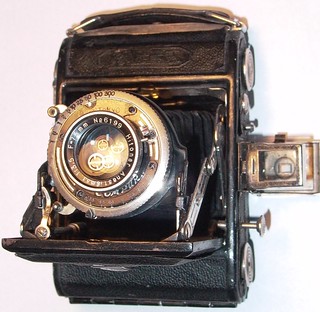Semi Miss

|
| w/ Hitonar 75/3.5 lens & Compur shutter image by eastwestphoto (Image rights) |
The Miss (ミース) or Semi Miss (セミミース)[1] is a Japanese 4.5×6 folding camera about which little is known. The spelling "Miss" is unsure and it could be "Mees", "Misu", "Mies", etc., instead.[2] It was perhaps distributed by Mizuno Shashinki-ten or by Sanwa Shōkai.[3]
Semi Miss == ==Semi Mees
The original Semi Miss or Semi MEES has a folding optical finder and a body release.[4] It was mentioned in the new products column of the March 1939 issue of Asahi Camera and was advertised in the February 1941 issues of Asahi Camera and Shashin Bunka.[5] The following lens and shutter combinations are reported:[6]
- Hitonar 75/3.5 lens, Tokyo Compur shutter, T, B, 1–300 speeds; [1]
- Hitonar 75/4.5 lens, T, B, 5–200 speeds.
This lens and shutter equipment is the same as on the Semi Konter and Rollekonter. The Hitonar lenses were certainly made by Kajiro Kōgaku, later Gojō then Kokusaku.[7] The Tokyo Compur shutter was certainly made by Bikōdō.[8]
The list of set prices compiled in October 1940 and published in January 1941, mentions a "Miss I" (¥74) and a "Miss II" (¥98), probably corresponding to the above versions.[9] The same models are in a similar price list date November 1941, where they are attributed to Mizuno Shashinki-ten.[10]
New Semi Miss
The New Semi Miss (新型セミミース) was featured in a column of the February 1942 issue of Asahi Camera. It is said to have a smaller body.[11] The lens is reported as a Grimmel 75/4.5,[12] a lens made by Fujita Kōgaku Kikai and also mounted on the Semi Gelto. The shutter is said to give T, B, 1–300 speeds.[13]
The government inquiry of April 1943 mentions a "Semi Miss".[14] In this document, the maker's name is unfortunately missing but the lens is given as a three-element Miss 75/3.5 and the shutter as a Patent Mars made by Mars and giving T, B, 1–250 speeds.[15]
Notes
- ↑ The camera is called ミース (Mīsu) in official price lists, and セミミース (Semi Mīsu) in the April 1943 government inquiry and in Kokusan kamera no rekishi, p.341.
- ↑ Kokusan kamera no rekishi, p.341, gives the spelling "Mees". Roman-letter spellings in this work are not completely reliable and "Miss" is more plausible. The camera was definitely called " Semi Mees". One known copy is owned by Eastwestphoto in USA.
- ↑ The camera is attributed to Mizuno in the official price list dated November 1941 and to Sanwa in Kokusan kamera no rekishi, p.341.
- ↑ Kokusan kamera no rekishi, p. 341.
- ↑ Kokusan kamera no rekishi, p.341.
- ↑ Kokusan kamera no rekishi, p.341.
- ↑ The "Kokusan shashinki no genjōchōsa" ("Inquiry into Japanese cameras"), lens item Lb32, attributes the U Hitonar 75/3.5 lens to Kokusaku.
- ↑ "Kokusan shashinki no genjōchōsa" ("Inquiry into Japanese cameras"), shutter item 18-Q-4, for the Tokyo Compur shutter of the Rollekonter.
- ↑ "Kokusan shashinki no kōtei kakaku", type 3, sections 4A and 7A.
- ↑ "Kamera no kōtei kakaku kanpō happyō", November 1941, type 3, sections 4A and 7A.
- ↑ Kokusan kamera no rekishi, p.341.
- ↑ Kokusan kamera no rekishi, p.341.
- ↑ Kokusan kamera no rekishi, p.341.
- ↑ "Kokusan shashinki no genjōchōsa" ("Inquiry into Japanese cameras"), item 57.
- ↑ "Kokusan shashinki no genjōchōsa" ("Inquiry into Japanese cameras"), lens item Lb9 and shutter item 18-U-12.
Bibliography
- Asahi Camera (アサヒカメラ) editorial staff. Shōwa 10–40nen kōkoku ni miru kokusan kamera no rekishi (昭和10–40年広告にみる国産カメラの歴史, Japanese camera history as seen in advertisements, 1935–1965). Tokyo: Asahi Shinbunsha, 1994. ISBN 4-02-330312-7. Items 262–3. (No advertisement is reproduced for this camera.)
- "Kamera no kōtei kakaku kanpō happyō" (カメラの公定価格官報発表, Official announcement of the set prices of the cameras), November 1941. Extract of a table listing Japanese camera production and setting the retail prices, reproduced in "Bebī Semi Fāsuto 'Kore ha bebī wo nanotta semi-ki da'" (ベビーセミファースト"これはベビーを名乗ったセミ機だ", Baby Semi First, 'this is a Semi camera called Baby'), an article by Furukawa Yasuo (古川保男) in Camera Collectors' News no. 277 (July 2000). Nishinomiya: Camera Collectors News-sha. P. 27. Type 3, sections 4A and 7A.
- "Kokusan shashinki no genjōchōsa" (国産写真機ノ現状調査, Inquiry into Japanese cameras), listing Japanese camera production as of April 1943. Reproduced in Supuringu kamera de ikou: Zen 69 kishu no shōkai to tsukaikata (スプリングカメラでいこう: 全69機種の紹介と使い方, Let's try spring cameras: Presentation and use of 69 machines). Tokyo: Shashinkogyo Syuppan-sha, 2004. ISBN 4-87956-072-3. Pp.180–7. Item 57.
- "Kokusan shashinki no kōtei kakaku" (国産写真機の公定価格, Set prices of the Japanese cameras), listing Japanese camera production as of October 25, 1940 and setting the retail prices from December 10, 1940. Published in Asahi Camera January 1941 and reproduced in Shōwa 10—40nen kōkoku ni miru kokusan kamera no rekishi (昭和10〜40年広告にみる国産カメラの歴史, Japanese camera history as seen in advertisements, 1935—1965). Tokyo: Asahi Shinbunsha, 1994. ISBN 4-02-330312-7. Pp.108—9. Type 3, sections 4A and 7A.
The Semi Miss is not listed in Sugiyama